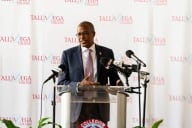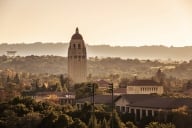You have /5 articles left.
Sign up for a free account or log in.

Kate Biberdorf, known to her fans as Kate the Chemist, breathes fire during a chemistry demonstration at the University of Notre Dame in 2023.
University of Notre Dame
When Kate Biberdorf, a professor known to her 287,300 TikTok followers as Kate the Chemist, gave a guest lecture at the University of Notre Dame last December, she deployed one of her signature science influencer moves: breathing fire to demonstrate a combustion reaction.
Her performance led to another dramatic outcome: Notre Dame offered Biberdorf, then an associate professor of instruction in chemistry at the University of Texas at Austin, a job as its inaugural professor for the public understanding of science.
Biberdorf’s new position, which she started this fall, is among the first professorships of its kind in the United States. It’s part of a broader plan by Notre Dame’s College of Science to engage scientific experts with a general public that’s both increasingly distrustful of scientists and bombarded with misinformation.
Biberdorf isn’t required to teach classes; instead, she has her own makerspace to develop ideas for publicly promoting scientific research through demonstrations and other projects.
“We have been treating science outreach as a side gig. It’s not a side gig,” said Santiago Schnell, dean of Notre Dame’s College of Science, who modeled the new professorship on one the University of Oxford first created in the mid-1990s. “It’s time that we get very serious about this, because the more advanced the science becomes, the more distance there will be between the general public and politicians and academia.”
Already the public’s view of scientists has taken a hit since the COVID-19 pandemic. In 2019, a Pew Research Center survey found that most Americans had a positive view of research scientists (though only about half viewed them as good communicators). But between 2019 and 2023, the share of American adults who said they had little to no trust in scientists rose from 13 percent to 27 percent, according to a 2023 Pew survey.
If anyone is equipped to overcome such challenges, it’s a professor like Biberdorf.
She got the job at Notre Dame in part because she already had years of experience translating her scientific knowledge into publicly digestible snippets. In addition to reaching people through her popular videos on social media, she hosts a podcast on NPR called Seeking a Scientist, has written science-related children’s books and appeared on television, and launched Fun with Chemistry, a Texas-based outreach organization designed to get K-12 students interested in science careers.
While Biberdorf has always had a flair for performance, she refined her stage presence and public messaging through a partnership with Amy Poehler’s Smart Girls, an organization the former Saturday Night Live cast member launched as a “place where people can truly be their weird and wonderful selves.”
“You don’t have to look like a stereotypical nerd with a bow tie. You can just be a scientist,” Biberdorf said in a video posted on the Smart Girls’ webpage back in 2018. “I’m coming for you, Bill Nye,” she warned, referring to the host of the hugely popular science education program Bill Nye the Science Guy, which aired on PBS in the 1990s.
And after an agent told her she had the potential to indeed become the next Bill Nye, she rebranded herself as a science entertainer named Kate the Chemist.
Over the past several years, Biberdorf has posted viral videos of herself doing science experiments and filmed science segments on programs such as The Late Show with Stephen Colbert, the Today show and The Kelly Clarkson Show.
“I’ve been on a 10-year journey to make science fun and accessible,” said Biberdorf, adding that she “loves to blow up stereotypes” and considers herself a role model for the next generation of scientists. “I want to show young kids—and everybody—that science is laced into everything we do.”
‘Part of What Being a Scientist Is’
To be sure, the rise of social media platforms such as YouTube, Instagram and TikTok has given a diverse cohort of medical professionals and research scientists the opportunity to share their expertise with people who are also exposed to other creators peddling inaccurate pseudoscience.
“It’s allowing many more people to have a voice,” said mathematician Marcus du Sautoy, who served as Oxford’s Charles Simonyi Professor for the Public Understanding of Science in 2008. “Of course, then we have to question if we trust those voices. This new professorship at Notre Dame will be able to use the university as a platform to legitimize the messages that are coming through a new channel that a professor might create.”
In addition to Notre Dame and Oxford, other universities in England, including the Universities of Sussex and Birmingham, are making investments in advancing the public understanding of science. But du Sautoy believes it’s incumbent on the entire scientific community to prioritize communicating their knowledge.
“We shouldn’t just rely on a few of these professorships,” he said. “We need to make it part of the whole fabric of the profession, that this is part of what being a scientist is: discovering science, teaching science, administering science—but also communicating to the public about science.”
Some academics say formalizing support for the ever-expanding group of social media–savvy scientists like Biberdorf is an overlooked tool universities could use to raise their research profiles as well as fight scientific misinformation.
While at UT Austin, Biberdorf juggled public communication with the traditional faculty responsibilities as both a chemistry instructor and director of demonstrations and outreach.
When it came time to apply for grants, both experiences helped her—and her colleagues—write successful applications that brought thousands of dollars in funding to their department. That’s because many granting agencies, including the National Science Foundation, require applicants to explain the broader impact of their proposed projects.
In an email to Inside Higher Ed, an NSF spokesperson said the agency prioritizes “outreach and transparency to the entire American public so they can see firsthand how that investment has improved their everyday lives and will continue to produce impacts that strengthen our economy and security for decades to come.”
It’s especially helpful when researchers can point to a concrete mechanism, like Biberdorf ’s outreach program, to show how they’ll communicate with the public.
“All of my colleagues immediately realized they could use me in their broader-impact section for their grant applications,” said Biberdorf, who worked with her UT colleagues to strategize ways to publicize their research. “It actually gets out into the community so researchers can talk about what they’re doing. Hopefully that gets people excited about it and will help that researcher get more grants in the future and more notoriety.”
One of her former colleagues, Michael Rose, an associate professor of chemistry at UT Austin, believes that pledging to use Biberdorf’s outreach program has helped him secure nearly $500,000 in grants.
Still, Rose said, “it’s hard to convince institutions” that having a faculty member dedicated solely to publicizing science can more than pay for itself by elevating an institution’s research efforts. “There’s not a historical model for it.”
That doesn’t mean departments should stop trying, he added. “It’s important to make the case that somebody who would be in that position would be catalytic in terms of being able to extract grant money from different agencies.”
Ben Rein, a neuroscientist with 713,800 followers on TikTok, was still completing a doctorate at the University at Buffalo when he made a viral video about proper mask wearing at the start of the pandemic. At first he kept his online persona separate from his professional life, fearful of negative reactions from his colleagues. Then he realized most of them had already seen his videos and approved of his efforts to debunk public health myths, explain how the human brain works and offer insights into the world of scientific research.
Rein, who went on to a research fellowship at Stanford University, didn’t get any explicit institutional support for his public communication endeavors, but he said doing so has return-on-investment potential.
For smaller schools especially, having a social media–savvy researcher is “a hugely overlooked resource,” Rein said, adding that while he was at Buffalo he recruited some students with an interest in science after they watched his videos.
Fighting Misinformation
Rein, who recently left academe to become chief science officer of the Mind Science Foundation, said his time as a science influencer showed him both “how fraught the relationships between science and society” are and how bringing more scientists into public conversations is an effective weapon against misinformation.
According to a peer-reviewed research paper he published in the journal Neuroscience in 2023, 84 percent of TikTok users he surveyed reported feeling more trustful of science and scientists after following Rein’s account.
“If we are not making efforts to engage the public beyond traditional methods, we are not only failing to achieve a major goal of science, but we’re also setting ourselves back because we’re actively losing to misinformation and nonexperts who pose as experts,” Rein said.
Figuring out the best way to combat scientific misinformation is one of Biberdorf’s priorities as she settles into her new role at Notre Dame.
“We want to be a safe, resourceful place for the community,” she said, adding that she plans to take a delicate approach to tackling misinformation in her new role. “We don’t want to attack any of the other people out there who are trying to communicate science and do good. We have to figure out what the balance is.”








